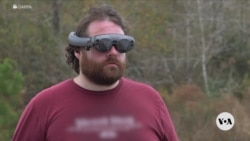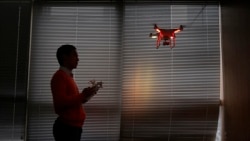ກອງທັບສະຫະລັດ ກ່າວວ່າກຸ່ມໂດຣນ ຫຼື ຫຸ່ນຍົນພາກພື້ນດິນກຸ່ມໃຫຍ່ສາມາດ ບໍລິຫານໂດຍຄົນພຽງຄົນດຽວໄດ້ ໂດຍບໍ່ເພີ່ມຄວາມກົດດັນໃຫ້ກັບຜູ້ຄວບຄຸມ ເລີຍ. ໃນລາຍການ LogOn ອາທິດນີ້, ຈູລີ ທາໂບ ນັກຂ່າວ VOA ມີລາຍ ງານກ່ຽວກັບເຕັກໂນໂລຢີເຫຼົ່ານີ້ອາດເປັນປະໂຫຍດສຳລັບການໃຊ້ງານໃນພາກພື້ນພົນລະເຮືອນອີກດ້ວຍ, ເຊິ່ງ ພຸດທະສອນ ຈະນຳລາຍລະອຽດມາສະເໜີທ່ານ.
ການທົດລອງພາກສະໜາມທີ່ສູນຝຶກອົບຮົມຂອງລັດຖະບານ ໄດ້ສະແດງໃຫ້ ເຫັນວ່າມະນຸດພຽງຄົນດຽວສາມາດບໍລິຫານຝູງໂດຣນ ແລະ ຫຸ່ນຍົນພາກພື້ນ ດິນຈຳນວນ 100 ເຄື່ອງຂຶ້ນໄປໄດ້ ໂດຍບໍ່ເພີ່ມກົດດັນໃດໆ, ຕາມຂໍ້ມູນຈາກ DAPRA ໜ່ວຍງານວິໄຈຂອງກະຊວງປ້ອງກັນປະເທດຂອງສະຫະລັດ.
ທ່ານນາງ ຈູລີ ເອ ອາດາມສ ຈາກມະຫາວິທະຍາໄລລັດ ອໍເຣກອນ ກ່າວວ່າ “ຜູ້ບັນຊາການຝູງ” ໃຊ້ອິນເຕີເຟດ ຫຼື ການໂຕ້ຕອບເໝືອນຈິງໃນກາານສົ່ງ ແລະ ຕິດຕາມຍານພາຫະນະ ພາຍໃນສະພາບແວດລ້ອມຈຳລອງທີ່ມີຄວາມ ກວ້າງ 10 ບຼ໋ອກ.
ພາລະກິດຂອງພວກມັນ: ແມ່ນເພື່ອສຳຫຼວດສະພາບແວດລ້ອມໃນເມືອງ - ຫຼີກ ລ້ຽງສິ່ງກີດຂວາງ ແລະ ສາຍໄຟ - ເພື່ອຮວບຮວມຂໍ້ມູນ.
ຜູ້ບັນຊາການຝູງ ສາມາດກົດປຸ່ມດຽວເພື່ອສັ່ງການຍຸດທະວິທີຫຼາຍຢ່າງໃຫ້ກັບ ຝູງ, ເພື່ອໃຫ້ຝູງສາມາດອອກໄປເຮັດວຽກໃນສິ່ງທີ່ມັນຄວນເຮັດ.
ການຄົ້ນພົບນີ້ສະແດງໃຫ້ເຫັນເຖິງສັກກະຍະພາບທັງໃນດ້ານທະຫານ ແລະ ພົນລະເຮືອນ... ເຊັ່ນ ການສົ່ງໂດຣນອອກໄປເພື່ອຕອບສະໜອງຕໍ່ໄພທຳມະ ຊາດ.
ທ່ານນາງ ຈູລີ ເອ ອາດາມາສ ກ່າວວ່າ "ເປົ້າໝາຍຄວາມຝັນໄລຍະຍາວ ຄືການສາມາດມີທີມຫຸ່ນຍົນຫຼາກຫຼາຍປະເພດ ເຮັດວຽກຮ່ວມກັບມະນຸດໃນສະຖານະການເຊັ່ນ ການຕອບສະໜອງຕໍ່ໄຟໄໝ້ປ່າ ຫຼື ໄພພິບັດ ເພື່ອສ້າງຜົນກະທົບຕໍ່ສັງຄົມຢ່າງແທ້ຈິງ."
ພວກເຮົາຕ້ອງການໃຫ້ມະນຸດມ່ງເນັ້ນໄປທີ່ວຽກທີ່ພວກເຂົາຈຳເປັນຕ້ອງເຮັດທີ່ສຸດ ເຊິ່ງຫຸ່ນຍົນບໍ່ສາມາດເຮັດໄດ້ແທ້ໆ, ແຕ່ຍັງຕ້ອງເຮັດໃຫ້ແນ່ໃຈວ່າຜູ້ຕອບສະໜອງເຫດການຂອງພວກເຮົາ, ຍົກຕົວຢ່າງ, ຈະປອດໄພກວ່າເກົ່າ.
ໂດຣນຍັງສາມາດຖືກນຳໃຊ້ - ແລະ ໃນຄວາມເປັນຈິງກໍ່ມີການໃຊ້ງານຢູ່ແລ້ວ -- ນຳໃຊ້ສຳລັບການສົ່ງມອບວັດສະດຸທີ່ໄວຂຶ້ນ.
ທ່ານນາງ ຈູລີ ເອ ອາດາມສ ກ່າວວ່າ "ໃນປັດຈຸບັນ, ກົດລະບຽບຂອງ FFA [ອົງການບໍລິຫານການບິນແຫ່ງຊາດ] ຈຳກັດຈຳນວນພາຫະນະທີ່ບຸກຄົນດຽວສາມາດຄວບຄຸມໄດ້, ແລະ ໃນອະນາຄົດ, ພວກເຮົາຕ້ອງການທີ່ຈະເພີ່ມຈຳນວນດັ່ງກ່າວຂຶ້ນສຳລັບບຸກ ຄົນດຽວ."
ໂຄງການນີ້ຍັງຢູ່ໃນຂັ້ນຕອນຂອງການພັດທະນາ, ແຕ່ນັກວິໄຈກ່າວວ່າ ການ ຄົ້ນພົບນີ້ອາດສົ່ງຜົນກະທົບຢ່າງໄວວາທັງໃນຕ່າງປະເທດ ແລະ ໃນສະຫະລັດ ເອງ.
Field experiments at a government training facility demonstrate that a single human can manage a swarm of 100 or more autonomous drones and ground robots without added stress, according to the U.S. Defense Department’s research agency DARPA
The “Swarm Commander” uses a virtual reality interface to deploy and monitor the vehicles within a 10-block simulated environment.
Their mission: to navigate the urban environment — avoiding obstacles and power lines — to collect intelligence.
“The swarm commander can basically hit a single button to issue multiple tactics to the swarm, so that the swarm can go out and do the things that it's supposed to do.”
The findings show potential for military as well as civilian purposes… such as sending out drones to respond to natural disasters.
“The long-term dream goal is actually to be able to have heterogeneous teams of robots ((35:58)) working alongside teams of humans in something like wildland fire response or disaster response in order to have a true societal impact.”
“We want to be able to have humans focus on the task that they absolutely must do that robots really can't do, but also ensure that our responders, for example, are safer.”
Drones can also be used – and in fact are already being used -- for speedier package deliveries.
“Currently, the FAA [Federal Aviation Administration] regulations limit how many vehicles a single individual can supervise, and in the future, we would like to be able to scale that number up for a single individual.”
The program is still in development, but researchers say their findings may quickly have impacts overseas as well as in the U.S.







ຟໍຣັມສະແດງຄວາມຄິດເຫັນ